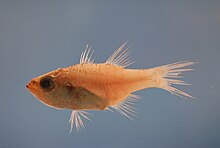Bigtooth cardinalfish
| Bigtooth cardinalfish | |
|---|---|

| |
| Scientific classification | |
| Domain: | Eukaryota |
| Kingdom: | Animalia |
| Phylum: | Chordata |
| Class: | Actinopterygii |
| Order: | Kurtiformes |
| Family: | Apogonidae |
| Subfamily: | Apogoninae |
| Genus: | Paroncheilus J. L. B. Smith , 1964
|
| Species: | P. affinis
|
| Binomial name | |
| Paroncheilus affinis (
Poey , 1875) | |
| Synonyms[2] | |
| |
The bigtooth cardinalfish or longtooth cardinalfish (Paroncheilus affinis)
Description
The bigtooth cardinalfish grows to a maximum length of about 11 cm (4.3 in). It is a laterally compressed fish with a large head, short snout and large eye. The obliquely-set mouth is moderately large and the lower jaw projects forward. Each jaw has a row of tiny teeth interspersed by some large
Distribution and habitat
The bigtooth cardinalfish is native to the tropical Atlantic Ocean. In the east, its range extends along the Atlantic coast, from Ivory Coast to Angola, including the
Ecology
The bigtooth cardinalfish is nocturnal, concealing itself in crevices and caves during the day. Large schools sometimes form near the base of underwater cliffs. It is carnivorous, feeding on small fishes and squids, crustaceans and benthic invertebrates. Breeding takes place throughout the year, with a male and female forming a pair bond before spawning. This species is a mouth brooder; some authorities state that the male incubates a ball of eggs in its mouth,[1] while other authorities state that mouth brooding is performed by both parents.[3][5]
Status
In general this fish faces few threats because its typical rocky habitat is not under threat and it is of no commercial interest. It is however vulnerable to predation by the invasive red lionfish (Pterois volitans) in the Caribbean region; this is a voracious venomous species which feeds at night and swallows fish the size of the bigtooth cardinalfish whole.[1][6] Elsewhere it is a common fish and the International Union for Conservation of Nature has assessed its conservation status as being of least concern.[1]
References
- ^ .
- ^ Baillie, Nicolas (2020). "Paroncheilus affinis (Poey, 1875)". WoRMS. World Register of Marine Species. Retrieved 7 May 2020.
- ^ a b c "Species: Paroncheilus affinis, Bigtooth cardinalfish". Smithsonian Tropical Research Institute. Retrieved 7 May 2020.
- PMID 25112246. Full paper
- ^ a b c Froese, Rainer; Pauly, Daniel (eds.) (2015). "Paroncheilus affinis" in FishBase. August 2015 version.
- .

